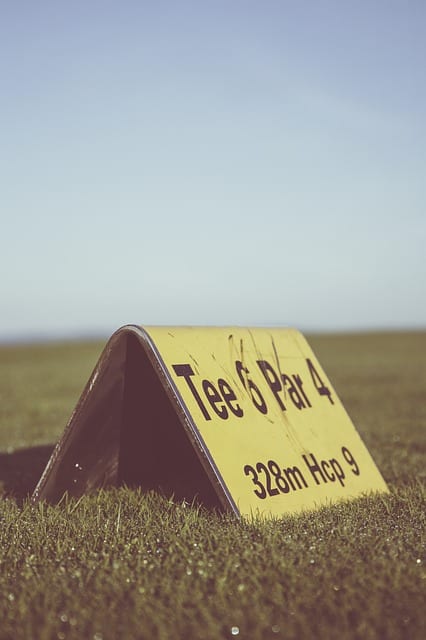With so many different names for the scores in golf, it can seem incredibly confusing. But scoring in golf is actually quite simple. In this article we’ll go through how it works and what the different scores are called.
The most common golf format, the one that’s on TV almost every week, is called stroke play (a stroke is just another name for a shot). It’s actually really simple.

In professional golf, competitors play 18 holes (a full course) each day for 4 days (for a total of 72 holes). Whichever golfer has played in the least number of shots wins. Easy!
But where it gets more confusing is in the names of the scores on each hole. There’s a name for each score, which depends on the par of the hole.
The best place to start is with the term “par”. You’ve probably heard it used before, for example: “I’m not feeling up to par today”. Par is considered the desired score, hence why “not feeling up to par” can be used to mean “not feeling very well”.
Basically, there are three types of hole in golf:
On a par 3 hole, the player is expected to take 3 shots, on a par 4 it’s 4 shots, and on a par 5 it’s 5. Simple, right? Bear in mind that the par system is based on professional golf scores, not amatuers or average club golfers.

It may seem like these numbers are plucked out of thin air but they’re not. The par of a hole is actually based on the number of shots required to reach the green.
And then, a player is given 2 putts on the green to get the ball in the hole. That’s 1 putt to get the ball near the hole, and 1 more to get it in.
So if it’s possible to reach the green in 1 shot, it’s a par 3 hole. This is because once on the green, the player is expected to take 2 putts. So in total, that’s 1 approach shot, and 2 putts, for a par 3.

A par 4 is a longer hole. They’re generally not reachable in 1 shot (unless the player can hit the ball a long way). Because of the length of the hole, the player is expected to get the ball on the green in 2 shots rather than 1. So that’s 2 shots to get onto the green and then 2 putts for a total of 4 shots on a par 4.
And a par 5 is an even longer hole. These are generally not reachable in 2 shots (except by big hitters). On a par 5 a player is allotted 3 shots to reach the green. Combined with 2 putts on the green, that makes the 5 shots of a par 5.

In reality, it doesn’t matter how the player makes the score, a 5 on a par 5 is still a par. The player may have hit the ball in the trees, on the driving range, onto the car park, and into a bunker before hitting the sand shot into the hole. It would still count as a par.
As well as the score on each hole, “par” is also used to refer to the expected score for the entire course. For example, many golf courses are a par 72. Remember, this is the number of shots a professional is expected to take, not an amateur golfer.
Almost every course consists of 18 holes made of par 3s, par 4s, and par 5s. But depending on how many of each hole the particular course has, will depend on the overall par of that course.

So if an 18 hole course had only par 3 holes, it would be a par 54 (18 holes x par 3). On the other hand, if an 18 hole course had only par 5s, it would be a par 90 (18 holes x par 5). In reality, practically every course has a mix of par 3s, par 4s, and par 5s. But hopefully that helps to explain the par of a course.
Many people reasonably assume that the term “par” comes from golf. But in fact, it doesn’t, it actually comes from the stock exchange.
“Par” used to be used to describe whether a stock was above or below it’s normal value, which was known as “the par”. A stock could be described as being under par or over par, depending on how it was performing.

In 1870, a reporter called A H Doleman was thought to be the first person to apply the term “par” to golf. At the time, there was no way to refer to the average number of shots a professional golfer took on a particular course (or how many shots should be taken on each hole).
Today, for example, we may say that a particular course is a par 71. But at that time, this didn’t exist.
The story goes that Mr Doleman was covering The Open at Prestwick in 1870. At the time it was the biggest tournament in golf, and it still is one of the four majors. Back then, The Open was always held on the 12 hole course at Prestwick, and the trophy was known as “The Belt” (today the trophy is the “Claret Jug”).
Mr Doleman approached 2 professionals, Davie Strath and Jamie Anderson, and asked them what score would win The Belt. They told him that a score of 49 would be a perfect round, and would be a victorious score. Mr Doleman declared this the “par” of the course.

The golfer Young Tom Morris would go on to win The Open with a score of 2 over par for 3 rounds (36 holes). From that moment on, the term “par” was adopted and has been used ever since.
Now we know what a par is, it should be fairly easy to understand what a birdie is. A birdie is simply 1 shot under par on any hole. This is a good thing, it’s actually better than a par.
So, there are 3 different ways you can make a birdie. It can be done on a par 3, a par 4, or a par 5.

In general, the longer the hole, the easier it is to make a birdie. This may sound counter-intuitive but let me explain why.
On many par 5s, pro golfers can actually reach the green in 2 shots. This means there’s many times where they get 2 putts for a birdie, instead of having to putt it in 1.
Likewise, many par 4 holes can be reached in just 1 shot. This again gives the golfer 2 putts for the birdie.
But on a par 3, the best you can do is to get the ball on the green in 1 shot. That then requires you to make the putt in 1 for the birdie. That’s why a birdie on a par 3 is quite rare, although it does happen.
It’s true that many club golfers can’t hit the ball far enough to reach a par 5 in 2 shots or a par 4 in 1 shot. But, that doesn’t mean they can’t make some nice birdie opportunities. Often, they can get close to the green for their final approach, giving them a chance to get the ball close to the hole for a birdie. They sometimes hit a really got shot on a par 3 too – setting up a nice birdie putt!
There is no definite proof of the origins of the word “birdie”. However, there is a commonly held belief that it originated at The Atlantic City Club, USA in 1903.
The story goes that a group of 3 or 4 locals were playing a money match at the club. One of the them was a gentleman called Abner Smith, or Ab Smith for short. He hit a shot close to the hole, setting up a putt for a score of 1 under par on the hole. Ab declared it a “bird” of a shot, which at the time was a slang word for “cool”.

The group agreed that next time a player scored 1 under par on a hole, they would receive double money. Ab proceeded to hole the putt, and so the first birdie was made!
Following this event, a score of 1 under par on any hole would become referred to as a “birdie”. The term soon spread across America and Canada, before reaching the UK. Now, of course, it’s well known across the world. I think we owe a thanks to Mr Abner Smith, I’ll dedicate my next birdie to the man!
An eagle is a score of 2 under par on 1 hole. As with a birdie, an eagle can be scored on any hole including a par 3, par 4, or a par 5.

Eagles also tend to be more common on the longer holes. In order to score an eagle on a par 3, the player has to get a hole in one! For this reason, an eagle on a par 3 is very rare and is almost never referred to an eagle but rather a hole in one or an ace.
Whereas on a short par 4, many big hitters can reach the green in one shot, setting up a putt or a chip for an eagle 2. Likewise, many players can reach a par 5 in 2 shots, giving themself a putt or short shot for an eagle 3.
Ab Smith, the same golfer that is credited with coining the term “birdie”, is also thought to have coined the term “eagle” at the same golf club – The Atlantic City Club. It wasn’t long after the “birdie” was born that the “eagle” came into existance.
To be fair, it seems like a logical name. If a score of 1 under is called a birdie then a score of 2 under should probably be named after a rare bird. The eagle seems like a great choice – it’s rare and majestic, just like the score.

And just like birdie, the term has American origins. In fact, it wasn’t adopted in common usage in the UK until quite a while later. One of the earliest recorded uses of the term in the UK was in 1919, over 10 years after it came into use in America. But now it’s used by practically every golfer across the world!
In golf, an albatross is something very rare, just the like the bird itself! It’s the name given to a score of 3 under par on a signle hole. An albatross can only be scored on a par 4 or a par 5. That’s because it’s not possible to score lower than 1 on a par 3 (which would be an eagle)!

You can tell just how rare an albatross is since it requires a hole in one in a par 4 or a hole in 2 on a par 5. Not many par 4s can even be reached in 1 shot. More golfers tend to be able to reach par 5s in 2, making it a bit more likely on a par 5. But either way, an albatross is something that very few golfers ever achieve.
A double eagle is another name for an albatross. In fact, it is thought that the term “double eagle” actually came before the term “albatross”.
Legend has it that the amateur golfer Ab Smith from The Atlantic City Club in the USA introduced the term “double eagle”. This is the same golfer that is credited with introducing the terms “birdie” and “eagle”.

Along with his regular playing partners, they had different terms for all the different under par scores in golf. 3 under par was no different, it became known as a double eagle.
The term may seem strange. An eagle in 2 under and a double eagle is 3 under, which is not double. However, there may well be some sense behind it.
When Ab Smith and his playing partners devised the terms, they were playing money matches. In these matches, a birdie (1 under) earned double money, and an eagle (2 under) earned double again. So it would make sense that a score of 3 under would earn double an eagle. Hence the name, “double eagle”!

Although the term may make sense in a money match, it doesn’t seem to make much sense in a regular game of golf. In fact, the term is only really used in the USA these days. In the rest of the world, the term “albatross” is generally preferred.
Just as an eagle is rare bird, an albatross is an even rarer bird. It would seem a logical step to name a score of 3 under par after a rarer bird than an eagle.
It’s not entirely clear when the term came into use. The first reference to it was found in a newspaper in South Africa in 1931 where a golfer scored a hole-in-one on the par 4 18th at Durban Country Club. The newspaper made reference to this score being known as an “albatross” amongst golfers.

However, it is thought that the term was in common usage among golfers for quite a while before this. Although it’s generally accepted that the alternative name “double eagle” came first.
In terms of rarity, an albatross is actually rarer than a hole-in-one. That’s because the vast majority of hole-in-ones happen on a par 3, and are classed as eagles. Since par 3s are reachable in 1 shot, making a hole in one on these holes is much more likely.
But for a hole-in-one to count as an albatross, it has to happen on a par 4. Most golfers can’t even reach a par 4 in 1 shot! So in that sense, an albatross is more difficult (and better) than a hole-in-one.
However, not all albatrosses are a hole-in-one. An albatross can be made in 2 shots on a par 5. Although this is rarer than a hole-in-one, I think most golfers would rather make a hole-in-one given the choice!

Either way, an albatross is an incredible acheivement and something that any golfer should be proud of.
A condor in golf is something so rare that not many golfers even know it exists. It is the name given to a score of 4 under par on just one hole! It can only be acheieved on one type of hole and it requires a hole-in-one!
That’s right, a condor can only be acheived by making a hole-in-one on a par 5! Most golfers cannot reach a par 5 in 2 shots, let alone 1! This makes a condor not only unlikely but almost impossible!

Even professional golfers cannot reach par 5 holes in 1 shot! So under normal circumstances, a condor requires an extraordinary amount of luck.
The most likely way for a condor to happen is on a par 5 hole with a sharp dogleg. In golf, a dogleg is basically a hole that has a sharp angle to it, which can even be as much as a right angle!
Other factors that may make it possible include a dangerously strong helping wind or a dangerously steep and long hill!
Or maybe a cart path could come in handy?!

On some of these holes, it’s possible for the golfer to drive the ball over the corner of the dogleg. So even though the hole may be 510 yards on the scorecard, it could be just 310 yards in a straight line. Not that it’s a short hit though! A drive of the highest calibre is still required, as well as a great deal of luck for it to find the hole!
So unlikely is a condor that one has never been made in professional golf! In fact, there are only 5 recorded condors in the whole of golf!
The first known condor was thought to have been made by Larry Bruce in 1962 at Hope Country Club in the USA. It was a 480 yard par 5 dogleg right and he took his drive across the corner. 480 yards may seem like a short par 5 by modern standards but back in 1962 that was a very long hole!

There have been 4 verified condors since then but none have been recorded in professional golf. The main problem is that professional courses are designed to be very difficult. Virtually no condor opportunities exist in professional golf, barring some extraordinary luck of course.
Maybe one day a gale force wind will blow a ball 400 yards onto a cart path, before rolling down a steep hill and falling into the hole. It’s possible!
A bogey is the name for a score of 1 over par on a hole. Unlike a birdie, eagle, albatross, or condor, a bogey is generally considered a poor score. Since the golfer is supposed to make a par on average, a bogey is generally considered as losing a shot or “dropping a shot”.

Having said that, there can still be such thing as a”good bogey”. If a hole is particularly tough, doesn’t suit the player, or they’ve gotten themselves in trouble, than a bogey could be considered a good score. Of course, there are many scores worse than 1 over!
The term “bogey” wasn’t actually originally used to mean a score of one over par. “Bogey” was actually the name of the first stroke play system.

Even though from 1870 the term “par” was used for the expected total score on a course, there was no equivalent for each hole. Whereas as today we have a par on each hole (eg par 5), nothing of the sort existed. There was only a par for the entire course.
But in 1890, Mr Hugh Rotherham revolutionised the scoring system. He was Secretary of the Coventry Golf Club when he proposed a “par” for each hole. But this wasn’t to be known as the “par of the hole” until much later. Mr Rotherham instead called it the “ground score”, presumably to distinguish it from the “par score” which was the course total.
Other golf clubs adopted the idea and started using it during match play. It is thought that the term “bogey” was first used at The Great Yarmoth Club in the UK. The story goes that a Mr CA Wellman remarked to Dr Browne that “this player of yours is a regular bogey man”.
At the time, there was a popular song called “Hush, Hush, Hush, Here Comes the Bogeyman”. It referred to a popular mythical tale that parents used to tell children. They would threaten them that the “bogeyman” (some kind of ghost/monster) would come in their sleep if they didn’t behave. Nice huh?!

Presumably, Mr Rotherham used the phrase to mean that the golfer was so good he was scary? I guess if a golfer could keep scoring well on every hole they would be scarily good. Either way, from then on the term “bogey” became used to mean the “par” of a hole, instead of “ground score”.
This may sound confusing but stick with mem things get simpler!
Over time, the term “bogey” changed it’s meaning. It’s not entirely clear why the meaning changed but it seems to have started with the American Women’s golf association.
From 1893, they began working on a handicap system which would be adopted by the Men’s golf association shortly after. Instead of using the term “bogey” for the score on each hole, they used the term “par”, which had previously only been used for the course total.

This seemed to make sense though. The idea was to have a “par” for each hole, which then totals a “par” for the course. And so the scoring system as we know it today was born. Thank you to the American Women’s golf association for simplifying things!
From then on, the term “bogey” was no longer needed. But clearly, it stuck around. We don’t really know why, but it then became used to mean a score of 1 over par.
Presumably “bogey” had been used so much in golf that it had to find a new home. Also, it seems to make more sense for a bad score, since a bogeyman is not exactly a good thing!
A double bogey is a score of 2 over par on a hole. It’s called a double bogey because it’s twice as far over par as a bogey. It’s not the most inventive name but it serves a purpose.
A double bogey is almost never considered a good score by a professional golfer. But for an amateur, it’s possible that it could be a good score for them. Of course, this depends on their ability and difficulty of the particular hole.

It may seem strange that there isn’t a special name for a score of 2 over par. But presumably that’s because unlike a birdie, eagle, or albatross, a double bogey is generally not considered something special.
After a double bogey, which is 2 over par, there’s a triple bogey, which is 3 over par. Again, not a very imaginative name but not many golfers want to shout about a double bogey anyway!
After a triple bogey, the scores don’t really have names. But 4 over par is sometimes called a quadruple bogey. There’s also something else – a snowman.

A score of 8 on a hole is affectionately (tongue-in-cheek) known as a snowman. In professional golf, a snowman is generally the highest (worst) score that a player will make. It doesn’t happen often at the top of the game but it happens all the time amongst regular club golfers.
The names for the scores in golf are quite strange and I think they make scoring seem more confusing than it is. I’ve even learnt a few things myself doing research for this article.
But I think it’s important to consider that golf is a very old game. So much like the English language (and other languages), the words have evolved over time.

Golfers definitely have their own language and we’ve only just scratched the surface. But hopefully this article shows that golf isn’t that complicated or intimidating really. It’s just unique! And that’s not a bad thing in my view.

I’m Tom Rothwell and I’m a 3 handicaper that's obsessed with golf. You can often find me hitting balls on a driving range somewhere!
I'm on a journey to learn as much as possible about the great game. I've made Clean Strike Golf to share everything I discover along the way.